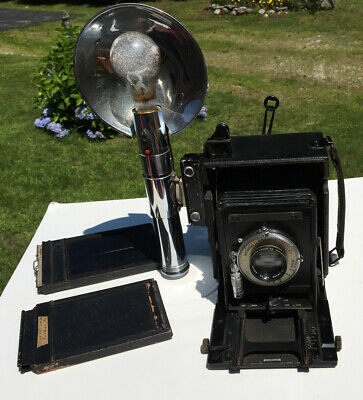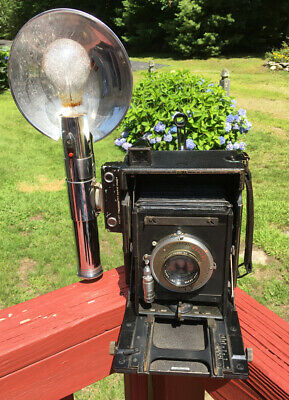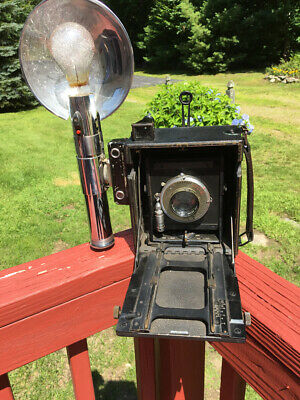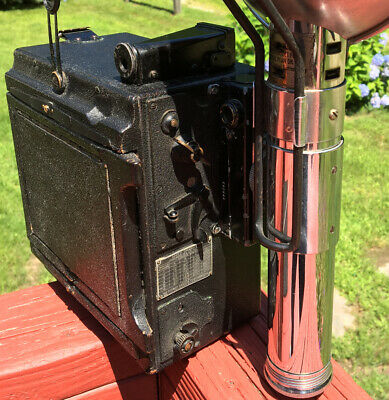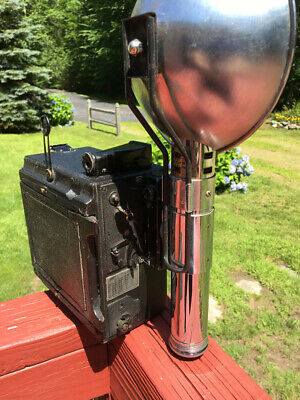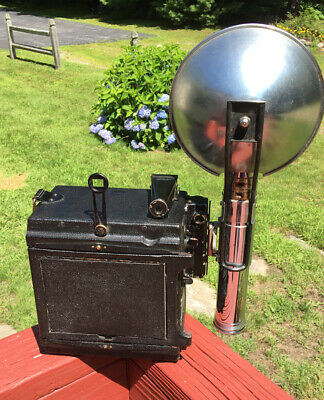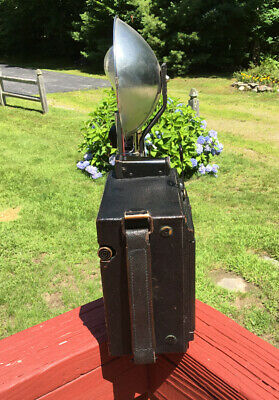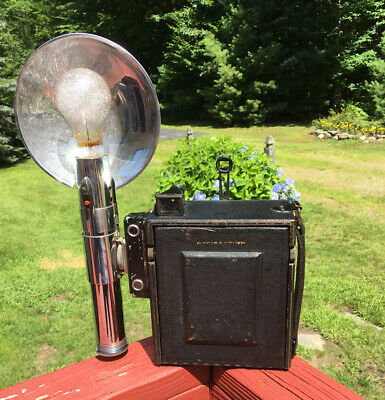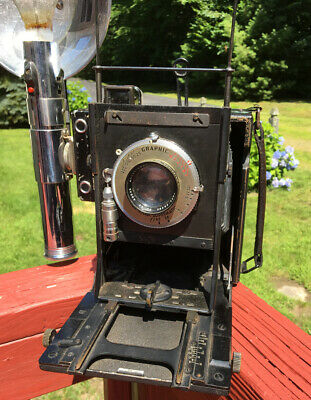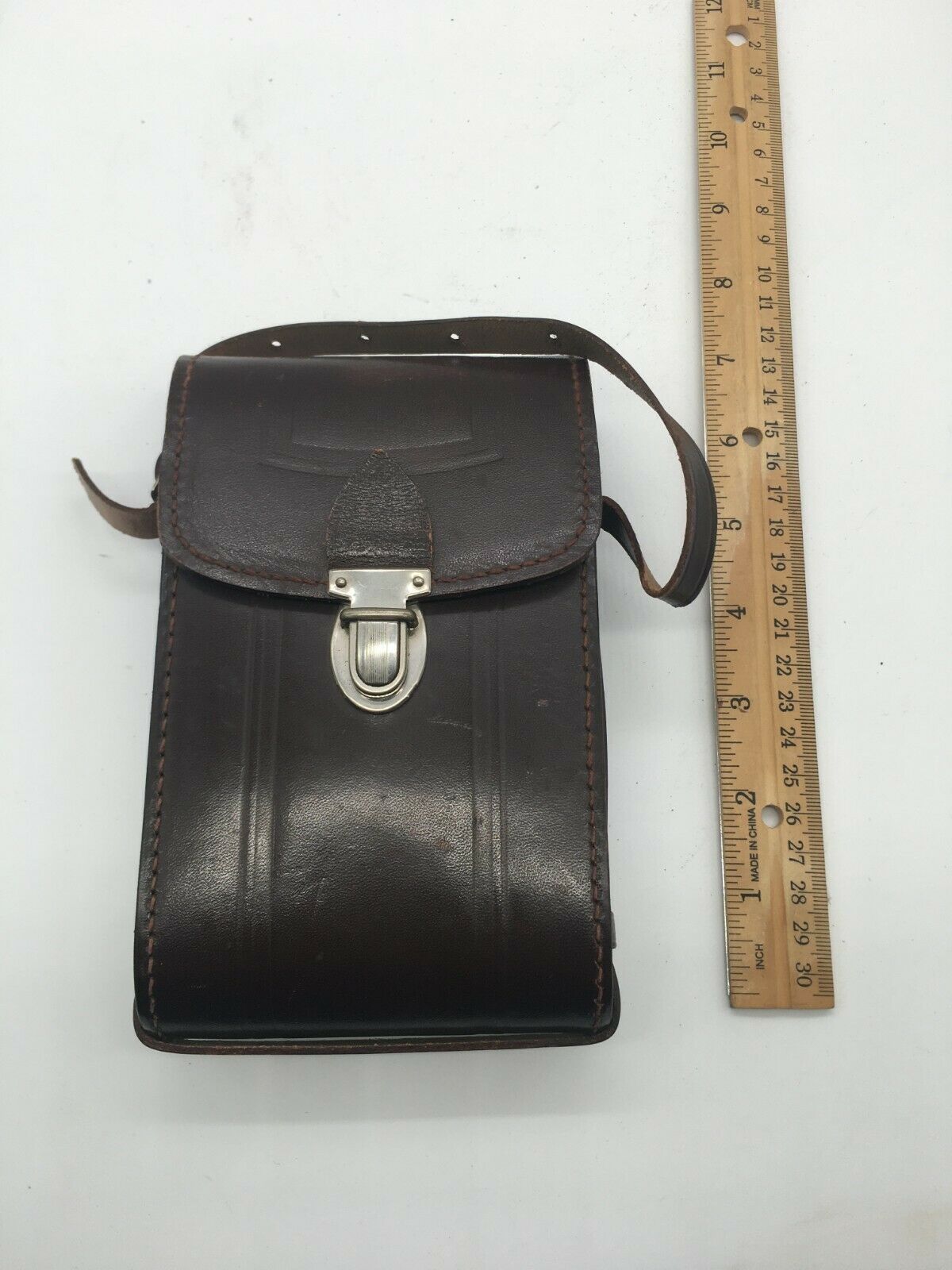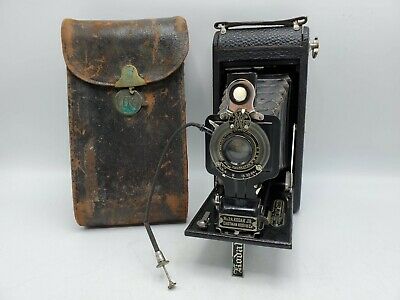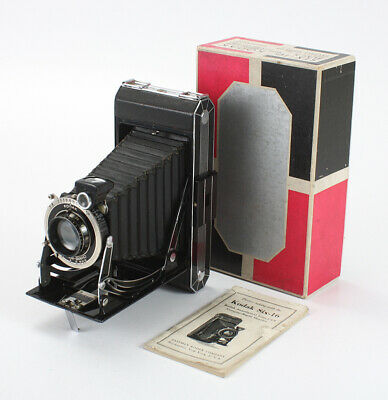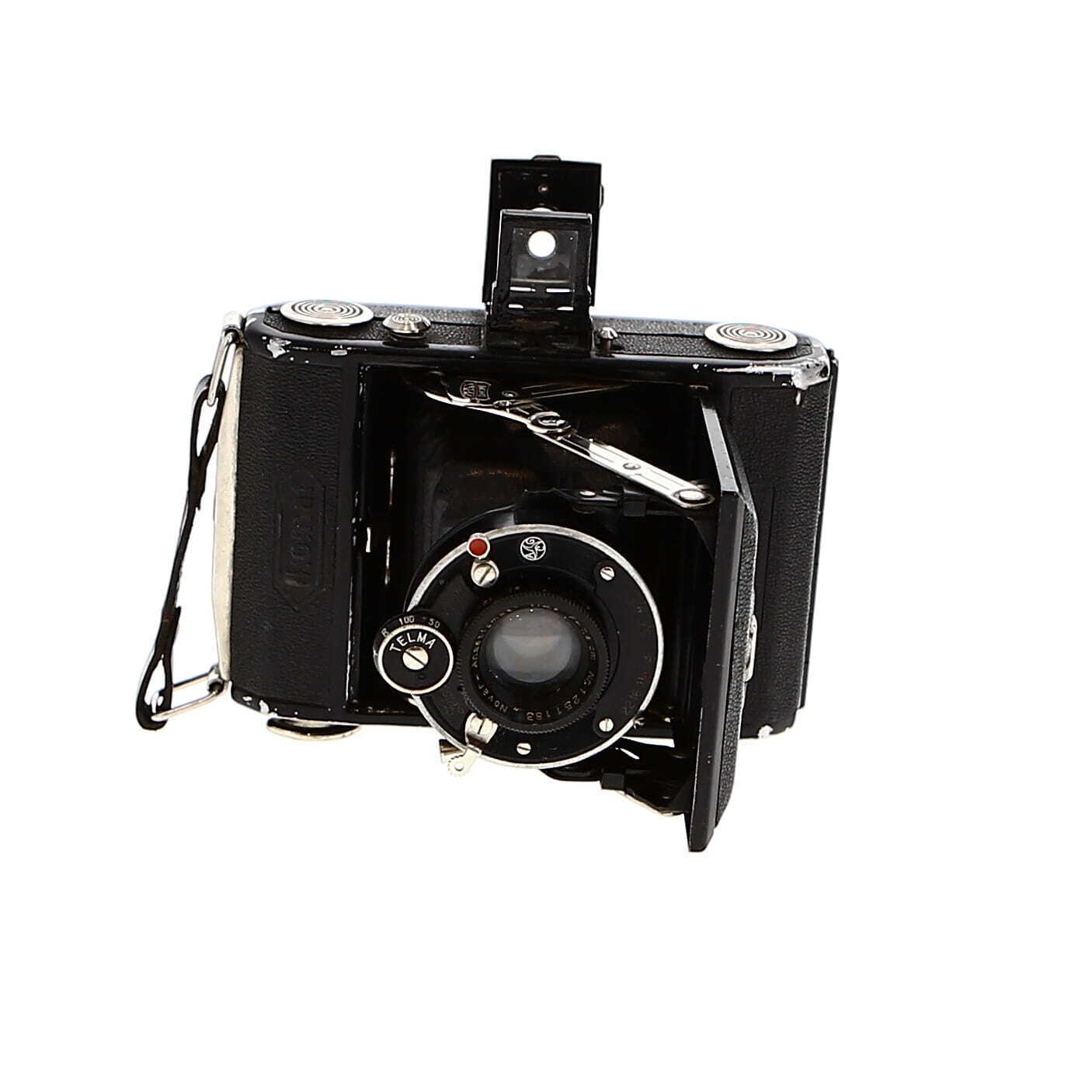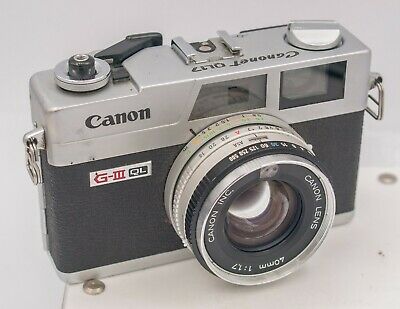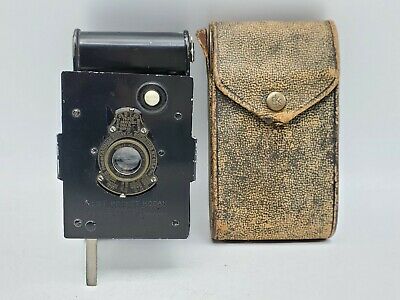-40%
"SPEED GRAPHIC" FOLMER GRAFLEX CAMERA LG FORMAT KODAK LENS F4.5 161MM FLASH
$ 147.81
- Description
- Size Guide
Description
Photographs throughout Ad:Offered for auction from a recent Estate sale is the following a GRAFLEX - SPEED GRAPHIC CAMERA as defined below:
ORIGINAL VINTAGE “SPEED GRAPHICS” 4.5 - 6 3/8 IN - CAMERA BY “FOLMER GRAFLEX CORP”, ROCHESTER, NY - CHROME FLASH WITH CONNECTIONS TO SHUTTER - LENS DESCRIPTION - GRAPHIC NO. 3 KODAK SUPERMATIC - ANASTIGMAT F-4.5 6 3/8 IN EM 32 - 2639K - NO. 32 - WITH KALART SYNCHRONIZED RANGEFINDER -- WITH 2 DOUBLE ORIGNAL FILM HOLDERS --
In side the case is a serial number of 329151. From research I believe that the EM on the Kodak Lens represent the year of 1943. - The Folmer Graflex Corp was in business from 1928-1946.
Below is additional information on the Graflex Speed Graphic camera and the Kodak Camera Lens. Co.
This camera is from an estate sale.
The Speed Graphics Camera appears to be in very good condition as photos shows. The bellows are complete without any damage as photos show. The camera is untested as to film development capabilities. The name "Speed" in Speed Graphic comes from the 1/1000s shutter speed offered by its focal-plane shutter. The Graflex focal-plane shutter is the essence of simplicity -- a single long curtain of rubberized fabric with a number of slits. The focal plane shutter functions fine as far as I can tell. The shutters on the lenses function open and close but can not be set and activated . The Shutter has a magnetic mechanism attached for connection I believe to the Chrome Flash Mechanism. The cable is not present in auction that would connect the two items together. The cable appears to be available on the internet along with batteries which are not in the flash mechanism. The Focal Plane shutters initially did not use these shutters from my research. The lenses appear clean along with the Sight and Kalart Synchronized Rangefinder. The lens information on the camera’s are as noted above (GRAPHIC - NO. 3 KODAK SUPERMATIC - ANASTIGMAT - F-4.5 - 6 3/8 IN - EM 32 - 2639K - NO. 32 -- On the lens top the following is also noted (Eastman Kodak Co., Rochester, N.Y.
Please view photos for condition. The Camera is sold as is. It has not been tested with film. This early camera is without the later chrome coated metal parts on the case. The metal parts are brass. In some instances the paint has worn off and the old age patina on the brass is present. The Kalart Rangefinder has a few nicks where the paint has been nicked off as photo may show. For the age I would say that the set is in very good condition as photos will also show. The combined Camera Weight with Flash Mechanism is 7 lb’s 12 oz’s. The only detriment to the condition of the camera is what when the back is opened to view 2 fiber sheets unfold on the side to block outside light and to allow 2 fingers to simply fold them to close the back. One of the flaps has separated from the base when held it in position. Both Film holders are functional but exhibit ware on wood painted surface, one more than the other. Below I have added additional information from a number of different sources on the internet on the Graflex Corporation Camera Co., the Kodak Camera Co., Rochester, N.H. History, Tessar Lens and 23 photographs. Please view photos for condition. Note: Camera is sold as is.
The Speed Graphic was a press camera produced by Graflex in Rochester, New York. Although the first Speed Graphic cameras were produced in 1912, production of later versions continued until 1973; with the most significant improvements occurring in 1947 with the introduction of the Pacemaker Speed Graphic (and Pacemaker Crown Graphic, which was one pound [0.45 kg] lighter and lacked the focal plane shutter) which is present on this Speed Graphic Camera with Kodak lens.
Despite the common appellation of Speed Graphic, various Graphic models were produced between 1912 and 1973. The authentic Speed Graphic has a focal plane shutter “AS DOES THIS CAMERA OFFERED FOR AUCTION DOES” that the Crown Graphic and Century Graphic models lack. The eponymous name "speed" came from the maximum speed of 1/1000 sec. that could be achieved with the focal plane shutter. The Speed Graphic was available in 2¼ x 3¼ inch, 3¼ x 4¼ inch, 5 x 7 inch and the most common format 4.5 inch which is this camera size as noted above. Because of the focal plane shutter, the Speed Graphic can also use lenses that do not have shutters (known as barrel lenses) when originally issued.
The Speed Graphic was a slow camera. Setting the focal plane shutter speed required selecting both a slit width and a spring tension. Each exposure required the photographer to change the film holder, open the lens shutter, cock the focal plane shutter, remove the dark slide from the inserted film holder, focus the camera, and release the focal plane shutter. Conversely, if the lens shutter were used, the focal plane shutter (on the Speed Graphic and Pacemaker Graphic models with both shutters) had to be opened prior to cocking using the "T" or TIME setting, and then releasing the shutter in the lens. If indoors, the photographer also had to change the flashbulb. Each film holder contained one or two pieces of sheet film, which the photographer had to load in complete darkness. Two of these original film holders are in the auction with the camera and flash unit. Faster shooting could be achieved with the Grafmatic film holder—a six sheet film "changer" that holds each sheet in a septum. Even faster exposures could be taken if the photographer was shooting film packs of 12 exposures, or later 16 exposures (discontinued in the late 1970s). With film packs one could shoot as fast as one could pull the tab and cock the shutter, and film packs could be loaded in daylight. A roll film adapter that used 120 or 220 film was available for 2.25 x 3.25, 3.25 x 4.25 and 4 x 5 inch cameras that permitted 8 to 20 exposures per roll, depending on the model of the adapter. Photographers had to be conservative and anticipate when the action was about to take place to take the right picture. The cry, "Just one more!" if a shot was missed was common. President Harry Truman introduced the White House photographers as the "Just One More Club."
The company name changed several times over the years as it was acquired and later spun off by the Eastman Kodak Corporation, finally becoming a division of the Singer Corporation and then dissolved in 1973. The award-winning Graflex plant in Pittsford, New York is still standing and is home to Veramark Technologies, Inc., formerly known as the MOSCOM Corporation. This camera has the following company name along with years of manufacture 1928-1946 Folmer Graflex Corp., Rochester, NY.
The majority of early Kodak Anastigmat lenses were of Tessar design and after WWII were coated and renamed as Ektars. However Kodak used the term anastigmat and later Ektar to cover a number of different lens designs from plasmats, wide angle and telephoto lenses.
Kodak lenses were made in the US, UK and Germany.
The names Eastman Kodak used for their lenses had little correlation the lenses' configuration or aperture. Instead, the name used was a marketing device indicating the relative quality of the optic. By the 1930s, all Kodak lenses, other than those of small (f/stop = f/8 or less) aperture, were Anastigmat. Kodak lenses were made not only for still cameras but also for enlargers, slide projectors, and for Cine-Kodaks and Kodascopes. Lenses for camera purposes were described as from the standpoint of general groups. Until the mid 1930s, even Kodak's best lenses were simply called Kodak Anastigmat. Beginning about 1935, with the advent of practical color photography, Kodak began classify lenses into tiered categories, though some existing lens lines (i.e. the professional large format Kodak Anastigmat f/4.5 lenses as located on this camera retained their original naming conventions. The first category introduced was the Kodak Ektars. These in particular represented an optical improvement over the usual anastigmat.
Many prewar Kodak lenses were sold as Kodak Anastigmat followed by a number. It would seem from catalogue data that numbers in the "thirty" series, like K.A. No.33 are Tessars, those beginning with 70 seem to be dialytes (four element air spaced type). The numbers in the Kodak Catalogue precede the lens name.
All data come from Kodak Reference Handbook, 1946 (practically unchanged from 1940-1946.)
No. 31 Kodak Anastigmat f/4.5 5 1/2in (140mm) - No. 32 Kodak Anastigmat f/4.5 6 3/8in (161mm) as installed on the Speed Graphic camera for auction. - No. 33 Kodak Anastigmat f/4.5 7 1/2in (190mm) - No. 34 Kodak Anastigmat f/4.5 8 1/2in (216mm) - No. 35 Kodak Anastigmat f/4.5 10in (254mm) - No. 36 Kodak Anastigmat f/4.5 12in (304mm) All appear to be Tessars (4 elements in 3 groups, 4 internal air surfaces)
Tessar History:
A Tessar comprises four elements in three groups, one positive crown glass element at the front, one negative flint glass element at the center and a negative plano-concave flint glass element cemented with a positive convex crown glass element at the rear.
Despite common belief, the Tessar was not developed from the 1893 Cooke triplet design by replacing the rear element with a cemented achromatic doublet. Paul Rudolph designed the Anastigmat with two lenses cemented in 1890. Later, Rudolph thought that a narrow airgap in the form of a positive lens would correct the spherical aberration (as did HL Aldis in 1895) and that this device was much better than the lenses cemented. In addition, this allowed the photographers to have greater freedom when choosing the lenses. In 1899 he separated the lenses in the Anastigmat to produce the fourth element, a group of four Unar lenses (which replaced the two interfaces cemented by the aforementioned device). In 1902, he realized that the two cemented interfaces had many virtues, so he reinserted them in the back of his Anastigmat, maintaining the "air gap" of the previous part of the Unar, thus creating the Tessar design (from the Greek word τέσσερα (téssera, four) to indicate a design of four elements) of 1902. The frontal element of the Tessar, like that of the Anastigmat, had little power since its only function was to correct the few aberrations produced by the powerful posterior element. The set of interfaces cemented in the posterior element had 3 functions: to reduce the spherical aberration; reduce the overcorrected spherical-oblique aberration; reduce the gap found between astigmatic foci.
The first Tessar appeared with a maximum aperture of f/6.3, but by 1907, the maximum aperture had been increased to f/4.5. In 1930, Ernst Wanderslab and Willy Merté from Zeiss developed Tessar lenses with apertures of f/3.5 and f/2.8.
Millions of Tessar lenses have been created by Zeiss and other manufacturers, and are still produced as excellent intermediate aperture lenses. The famous 50mm f/3.5 Elmar lenses used in the first Leica cameras were of this type, designed by Max Berek in 1920. Actually, Zeiss has a large monopoly on this type of construction, because Rudolph's patent was very general.
Kodak Anastigmat f/4.5 Lenses for commercial, portrait, and press work were available in a variety of focal lengths from 5 1/2 to 12 inches. They were supplied in barrels or shutters for mounting on interchangeable lens boards for use on appropriate cameras including view, studio, and press cameras of the Speed Graphic and Graflex types. They were highly corrected anastigmat and their excellence was attested by the popularity they long enjoyed among leading photographers. Although these lenses ought to have been re-labeled as Ektars, they retained their original appellations throughout their production runs due to their established reputation in the professional community.
I will accept PAYPAL and other Ebay payment methods. Items will be shipped Priority Mail usually next day after payment of Paypal, packaging and mail .95
